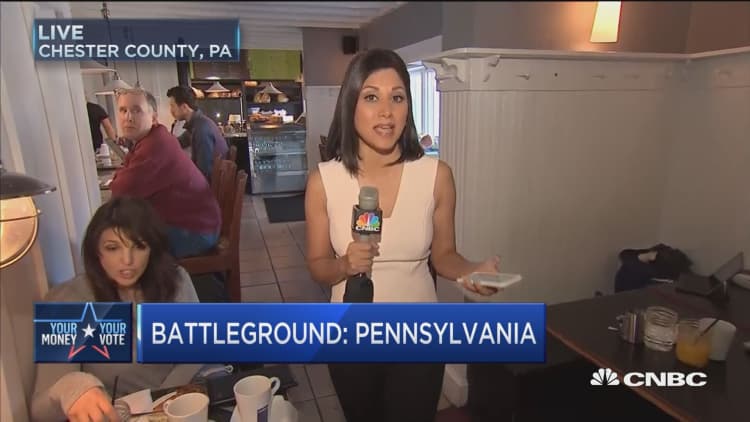
The campaign signs dotting the lawns of the stately homes in Chester County, Pennsylvania give away the county's swing status. And this year, Chester County's divisions are quite apparent, with opposing presidential candidate posters revealing the fissures between neighbors, friends, and even families.
Urban sprawl is slowly creeping into the bucolic pastoral scenes iconic to Chester County, which was once known as Philadelphia's "horse country." With it, comes big box stores, parking lots, and a possible shift in political winds.
While the county historically votes for Republican candidates, its most recent presidential picks have revealed more nuance and internal conflict. The county has only voted for two Democratic Presidents since 1964 – Lyndon Johnson that year, and Barack Obama in 2008. In 2012, the county chose Mitt Romney by 529 votes.
"I'm voting straight down the line this year," says Jessica Amoroso of West Chester, PA, who is voting for Donald Trump. "People assume that I am a Hillary supporter because I am a woman, it's really insulting. Nothing against Hillary, it's about the issues. I wasn't a big fan of Obamacare. I think the country needs a new direction."
According to U.S. Census figures, Chester County is 86 percent white, with a median household income of $86,093 (nearly $30,000 above the national average), and 49 percent of its residents have college degrees. While white, affluent, college-educated voters typically choose Republican presidential candidates, recent polls show Hillary Clinton edging out Trump in this demographic. In the most recent NBC/WSJ poll from November 6th, white college-educated voters chose Clinton over Trump, 51 percent to 41 percent. In contrast, whites without college degrees prefer Trump by a 2-to-1 margin, 60 percent to 30 percent.
Chuck Longbottom says he's choosing Clinton over Trump because of the latter's character. "I could no way ever vote for somebody as disgusting as Donald Trump … it was a no-brainer for me," he said.
Longbottom was among the voters at the Classic Diner in Malvern, an upscale diner in Malvern, PA attracting a cross-section of voters.
Across the way, Michael Battaglino says he's choosing Trump based on issues. "I'm voting for Donald Trump because I feel we need some change in different areas, taking charge again with military and economics with jobs, bringing them back into the United States."
Clinton and Trump have blanketed this battleground state. Clinton has visited PA 20 times since the Democratic convention, focusing on the state's urban, Democratic areas in and around Philadelphia and Pittsburgh. Trump has stumped in the statre 25 times since the Republican convention, targeting western and Northeastern PA, where he's addressed workers who have been adversely affected by the loss of manufacturing and coal mining jobs.
Both candidates have targeted suburban women — a critical swing demographic — in the four "collar counties" around Philadelphia. Clinton has spoken about her role as a mother, grandmother, and working woman. Trump has used his daughter, Ivanka, to roll out his child care plan in a Philadelphia suburb. Ivanka, a popular surrogate, has also held "Coffee With Ivanka" events in the Philadelphia suburbs. A study by NORC at the University of Chicago, an independent research institution, shows in the last seven presidential elections, suburban women have voted three times for the GOP candidates, and four times for Democratic candidates. In all the cases, the voting bloc picked the winner in each presidential contest since 1988.
For some women in Chester County, the choice is painful. "I'm voting for Trump because he is the lesser of two evils in my opinion," says Domenica Garzarella, a mom from Exton, PA.
Outside a polling place in Malvern, PA, voters trickled in throughout the day, casting ballots in a county that could help determine whether Pennsylvania turns red or blue in the 2016 presidential campaign.


